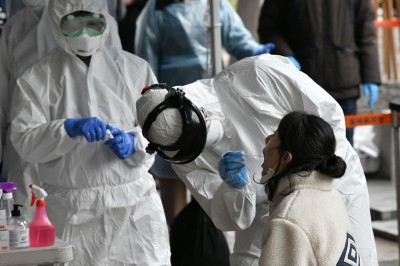As coronavirus outbreaks surge worldwide, research teams are racing to understand a crucial epidemiological puzzle - what proportion of infected people have mild or no symptoms and might be passing the virus on to others. Some of the first detailed estimates of these covert cases suggest that they could represent some 60% of all infections.
Many scientists have suspected that there is an undetected pool of covert cases showing limited to no symptoms, because an increasing number of infected people cannot be linked to known COVID-19 cases or travel to epidemic hotspots. Most people with mild infections would not be ill enough to seek medical help, and would probably slip past screening methods such as temperature checks, so the extent of the phenomenon and its role in virus transmission has remained elusive.
"Understanding the proportion of asymptomatic or mildly ill cases is just going to be really important for us to understand what is driving this particular epidemic," says Michael Osterholm, director of the University of Minnesota's Center for Infectious Diseases Research and Policy in Minneapolis.

This is different from the groups who are trying to understand the number of unreported cases - those that are missed because authorities aren't doing enough testing, or 'preclinical cases' in which people are incubating the virus but not yet showing symptoms.
To gauge the extent of covert infections, a team of researchers in China and the United States developed a model using clinical data from 26,000 laboratory-confirmed cases reported to the health commission of Wuhan, the epicentre of the outbreak, in the Chinese province of Hubei.
In a preprint posted online on 6 March, the group suggests that by 18 February, there were 37,400 people with the virus in Wuhan whom authorities didn't know about. Most of those unreported cases were in people who had mild or no symptoms but could still be contagious, according to the authors.
"By our most conservative estimate, at least 59% of the infected individuals were out and about, without being tested and potentially infecting others," says Wu Tangchun, a public-health expert at Huazhong University of Science and Technology in Wuhan, who led the study. "This may explain why the virus spread so quickly in Hubei and is now circulating around the world."
The team's results are within the range of the estimates of several other studies based on much smaller data sets, says Adam Kucharski, a disease modeller at the London School of Hygiene and Tropical Medicine. "It's the most recent analysis of the best data set we have," he says, and the methodology is sound.
But the model assumes that everyone in the community has the same opportunity to be in contact with anyone else. In reality, "you have more chances of interacting with a small fraction of people: your family, your friends and your colleagues", says Gerardo Chowell, a mathematical epidemiologist at Georgia State University in Atlanta. By assuming there is homogeneous mixing, he says, the model probably overestimates the transmission rate and exaggerates the number of infections with mild or no symptoms. But the result is in the right ballpark, he says.

Another study looked at 565 Japanese citizens who were evacuated from Wuhan in early February and were repeatedly tested and monitored for the virus and symptoms. In a paper published on 13 March in the International Journal of Infectious Diseases, a team in Japan reports that 13 evacuees were infected, of whom 4, or 31%, never developed symptoms.
But probably the best-documented evidence for asymptomatic cases has come from the Diamond Princess cruise ship, which had a COVID-19 outbreak in early February while in Japanese waters, says Chowell.
The ship was quarantined and the 3,711 passengers and crew members were repeatedly tested and closely monitored.
Chowell's modelling study, published on 12 March in Eurosurveillance, shows that about 18% of some 700 infected individuals on Diamond Princess never showed symptoms.
"You have to keep in mind that this was a special population" with lots of elderly people, says Chowell. Older people tend to fare badly when infected with the new coronavirus, so he suspects the rate of asymptomatic infections in a general population might be closer to the 31% that the Japanese team reported.
Taking the results from several studies into account, Chowell thinks that asymptomatic or mild cases combined represent about 40-50% of all infections.
But can people with mild or no symptoms infect others? In a preprint study posted on 8 March, a German-based team showed that some people with COVID-19 had high levels of the virus in throat swabs early in their illness, when their symptoms were mild.That means the pathogen could easily be released through coughs or sneezes - a process known as viral shedding - and spread to others, the researchers say.

Another team, in China, detected high viral loads in 17 people with COVID-19 soon after they became ill. Moreover, another infected individual never developed symptoms but shed a similar amount of virus to those who did, the researchers report yesterday in The New England Journal of Medicine.
These are the first detailed analyses of the extent of viral shedding at different stages of the disease, says Osterholm. The data confirm what many scientists have suspected: that some infected people "can be highly contagious when they have mild or no symptoms", he says. But he stresses that the scale of the problem is still unclear.
Many scientists fear that this might also have led to an underestimate of kids' susceptibility to the virus. A study of more than 700 infected children in China found that 56% had mild or no symptoms.
If the findings hold water, urgent measures are needed to curb mild and asymptomatic cases that are fuelling the pandemic, researchers say. They call for closing schools, cancelling public gatherings and generally keeping people at home and out of public spaces.
"Implementing strong social-distancing measures is the only way to stop the virus from spreading," says Chowell.